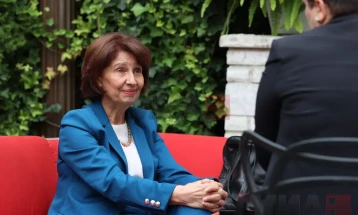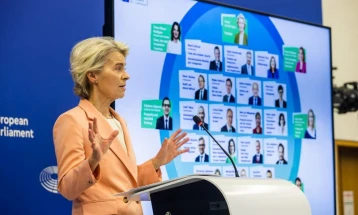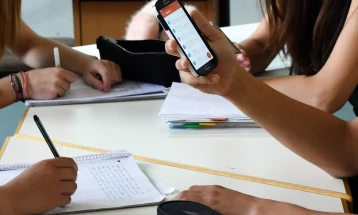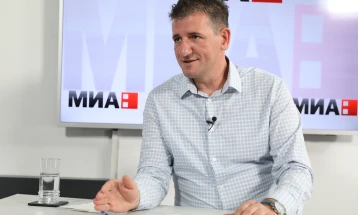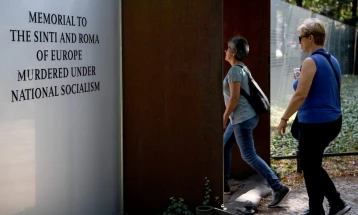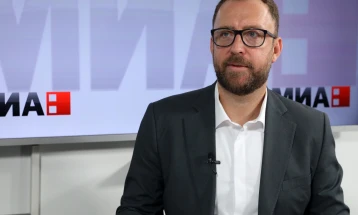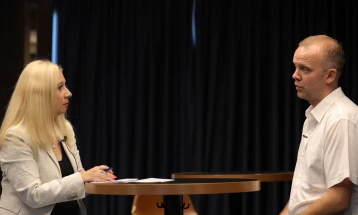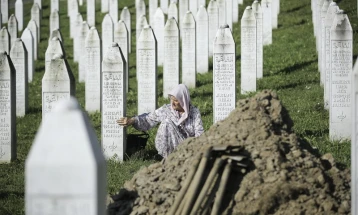Goran Babushku: Smart city – concept for a future without alternative, digital gap a challenge
- Post By Ivan Kolekevski
- 10:18, 4 July, 2022
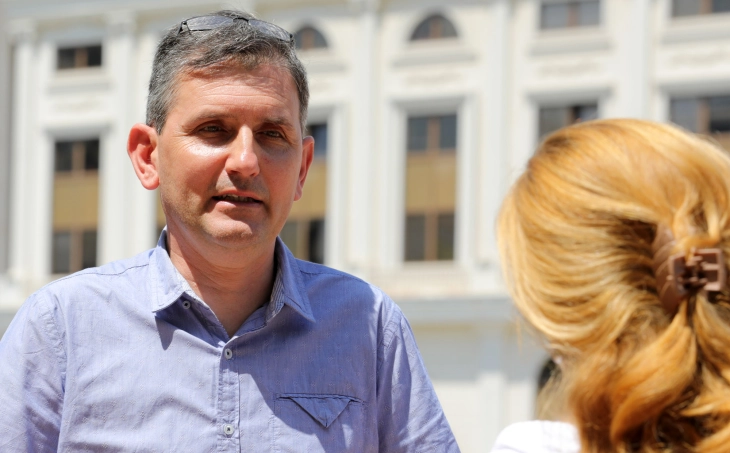
Skopje, 4 July 2022 (MIA) – The smart city concept includes the integration of new technologies, data and innovation in the management and development of cities, securing the best results for the community and the environment by improving the local economy, sustainability, security and resilience. It is a concept without an alternative which results in digitally literate citizens. Every modern city today is a digitized city, and digital inclusion is a priority for every local administration wanting to be considered successful.
Goran Babushku, an electrical engineer, who lives and works in Australia, has been leading, over the past two years, the team focused on digital solutions or smart city (Smart City Delivery Lead) at the Stonnington Municipality, Melbourne.
“With the progress of technology we all live in so-called smart cities where modern technologies are utilized all around us to greater or smaller extent. The aim is to connect, centralize and find the best way to use these technologies in order to solve the citizens’ problems. Some more advanced cities that have implemented the smart city concept in a more consolidated and sophisticated manner are Barcelona, Copenhagen, Basel, Philadelphia, Seoul, Singapore, London, and Melbourne. One can stumble upon modern technologies in many smaller cities, but the aim is not for the cities to compete but to share experiences from the results they’ve achieved, regardless of whether these experiences are good or bad,” says Babushku.
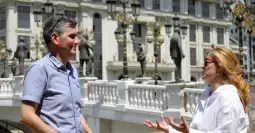 He emphasizes that an important feature of a “smart city” is the cooperation between the local community, volunteers, start-up companies, industry, and the business community in general. The most important part of the process is the collection of data from the citizens, the business and from inside of the municipality with the aim of coordinating all activities. Smart city means support for the local economy, for start-ups if their products are used in the management of the local community’s processes. An example is the production of sensors tracking air quality, which can be used to measure the air quality in closed spaces as well, creating more optimal work conditions.
“We began working on some smaller projects, pilot projects, some of them were remote controlled parking lights, i.e., smart lighting, then smart parking, as well as the implementation of sensors tracking traffic frequency, i.e., the number and type of vehicles, their speed, the number of pedestrians, cyclists using the city road networks. As the people in the municipality found out more about the monitoring, they realized they can demand more from the new technology, the traffic engineers saw that with the help of this technology they can make traffic more secure,” says Babushku.
He emphasizes this is only the beginning and as the data collection progresses, new generations will arrive who will be able to solve new challenges on the basis of this data. The new digital technology is also used in waste management.
The amount that the municipality allocates for a smart city cannot be precisely defined, because, he says, it is a concept which they are trying to implement in every project, in order to have transparent control and management of all of the city’s means in order to prepare it for the future. This includes remote control from a single place, from one control table, of public lighting, the toilets in the parks, parking lots, corporate buildings, recreational centres, local sport clubs and even manifestations and events taking place in the open, which helps simplify the work process, save human and material reserves, electricity, while getting quality services at the same time.
Digital inclusion
Digital inclusion is inseparable from the smart city concept because it means the inclusion of every member of the community, so that even the smallest marginalized groups can become a part of the modern digitized processes. Research has shown that digital inequality reinforces social inequality, and it is in the interest of every municipality to lower the digital gap or to remove it entirely.
In Australia, every municipality implements digital inclusion in a way that’s in accordance with its needs, according to the age of the population, the different language varieties they use, and hardware and internet access. Our municipality is only at the beginning of the structural implementation of the smart city concept. Other municipalities are ahead with the implementation of the new concept, such as Casey, one of the bigger municipalities in the south of Melbourne, with a significant population of socially and economically threatened families.
He emphasizes that an important feature of a “smart city” is the cooperation between the local community, volunteers, start-up companies, industry, and the business community in general. The most important part of the process is the collection of data from the citizens, the business and from inside of the municipality with the aim of coordinating all activities. Smart city means support for the local economy, for start-ups if their products are used in the management of the local community’s processes. An example is the production of sensors tracking air quality, which can be used to measure the air quality in closed spaces as well, creating more optimal work conditions.
“We began working on some smaller projects, pilot projects, some of them were remote controlled parking lights, i.e., smart lighting, then smart parking, as well as the implementation of sensors tracking traffic frequency, i.e., the number and type of vehicles, their speed, the number of pedestrians, cyclists using the city road networks. As the people in the municipality found out more about the monitoring, they realized they can demand more from the new technology, the traffic engineers saw that with the help of this technology they can make traffic more secure,” says Babushku.
He emphasizes this is only the beginning and as the data collection progresses, new generations will arrive who will be able to solve new challenges on the basis of this data. The new digital technology is also used in waste management.
The amount that the municipality allocates for a smart city cannot be precisely defined, because, he says, it is a concept which they are trying to implement in every project, in order to have transparent control and management of all of the city’s means in order to prepare it for the future. This includes remote control from a single place, from one control table, of public lighting, the toilets in the parks, parking lots, corporate buildings, recreational centres, local sport clubs and even manifestations and events taking place in the open, which helps simplify the work process, save human and material reserves, electricity, while getting quality services at the same time.
Digital inclusion
Digital inclusion is inseparable from the smart city concept because it means the inclusion of every member of the community, so that even the smallest marginalized groups can become a part of the modern digitized processes. Research has shown that digital inequality reinforces social inequality, and it is in the interest of every municipality to lower the digital gap or to remove it entirely.
In Australia, every municipality implements digital inclusion in a way that’s in accordance with its needs, according to the age of the population, the different language varieties they use, and hardware and internet access. Our municipality is only at the beginning of the structural implementation of the smart city concept. Other municipalities are ahead with the implementation of the new concept, such as Casey, one of the bigger municipalities in the south of Melbourne, with a significant population of socially and economically threatened families.
 In order to reduce the digital gap, the city of Casey last year launched its first framework for digital capital in order to improve digital equality and strengthen the municipality. It was developed in consultations with the citizens of Casey, businesses and community groups, the framework creates guidelines and activities for the delivery of digital resources and infrastructure improving online access, trust and digital literacy in Casey. The local administration’s opinion is that all members of the community deserve fair access to the digital resources and the additional benefits, which then builds digital strength and digital democracy.
Among the initial activities established by the framework are: the increase of internet access, identifying key locations for the installation of free public Wi-Fi stations, mapping free Wi-Fi points through the creation of an online map of the community’s service organizations, schools, the general community and building digital skills so as to overcome the social isolation of the vulnerable population and the digital exclusion, which have been worsened by the COVID – pandemic.
The digital inclusion, according to Babushku, is an element which should be implemented and supported. This requires two points: securing free or cheap internet and a computer. An excellent example of this is the city of Philadelphia where the city authorities, he says, in agreement with telecommunication companies, allow for cheaper internet networks, for socially vulnerable citizens, to be installed on the roofs of their municipal buildings instead of a network of 5G antennae.
“The marginalized people can be 1 percent, they can even be 0.1 percent of the population, but they are a very important factor which we must bring down to zero,” emphasizes Babushku, who approaches the questions of social, i.e., digital inclusion, with great enthusiasm.
“Donate a Computer” – a successful domestic model
A great example of the support for digital inclusion in Macedonia, says engineer Babushku, is Donate a Computer (DC). He found out about it through Twitter, and started actively following it on LinkedIn.
“DC is an essential part of a smart city, if not a critical part. At a moment of drastic technological development it is very important for all citizens to be allowed to have access to modern technologies. Not long ago the United Nations declared internet access as a basic human right, and the DC activities are not only to be actively commended but also should be supported by the authorities, the industry and the people. DC communicates with local communities and volunteers (community engagement), with donors (stakeholders engagement) and with media (public relations),” notes the IT expert..
In order to reduce the digital gap, the city of Casey last year launched its first framework for digital capital in order to improve digital equality and strengthen the municipality. It was developed in consultations with the citizens of Casey, businesses and community groups, the framework creates guidelines and activities for the delivery of digital resources and infrastructure improving online access, trust and digital literacy in Casey. The local administration’s opinion is that all members of the community deserve fair access to the digital resources and the additional benefits, which then builds digital strength and digital democracy.
Among the initial activities established by the framework are: the increase of internet access, identifying key locations for the installation of free public Wi-Fi stations, mapping free Wi-Fi points through the creation of an online map of the community’s service organizations, schools, the general community and building digital skills so as to overcome the social isolation of the vulnerable population and the digital exclusion, which have been worsened by the COVID – pandemic.
The digital inclusion, according to Babushku, is an element which should be implemented and supported. This requires two points: securing free or cheap internet and a computer. An excellent example of this is the city of Philadelphia where the city authorities, he says, in agreement with telecommunication companies, allow for cheaper internet networks, for socially vulnerable citizens, to be installed on the roofs of their municipal buildings instead of a network of 5G antennae.
“The marginalized people can be 1 percent, they can even be 0.1 percent of the population, but they are a very important factor which we must bring down to zero,” emphasizes Babushku, who approaches the questions of social, i.e., digital inclusion, with great enthusiasm.
“Donate a Computer” – a successful domestic model
A great example of the support for digital inclusion in Macedonia, says engineer Babushku, is Donate a Computer (DC). He found out about it through Twitter, and started actively following it on LinkedIn.
“DC is an essential part of a smart city, if not a critical part. At a moment of drastic technological development it is very important for all citizens to be allowed to have access to modern technologies. Not long ago the United Nations declared internet access as a basic human right, and the DC activities are not only to be actively commended but also should be supported by the authorities, the industry and the people. DC communicates with local communities and volunteers (community engagement), with donors (stakeholders engagement) and with media (public relations),” notes the IT expert..
 In Australia, he says, despite the high development of the country, there are still challenges such as accessing these communities in order to hear their voice. DC successfully implements this, donating a computer to 1,700 families is nothing to scoff at.
It is important to note here, that DC with its idea, actively contributes to the continuation of the lifetime of, at first sight, aged technology, which lowers electronic waste and is basically a circular economy.
He fully supports the activities of this non-profit and non-governmental organization, and their relations today are on the level of exchanging ideas and suggestions in order to increase awareness for the importance of digital inclusion in the country.
Donate a Computer and its founder Borche Stamenov, together with the team, have voluntarily worked for six years now, in order to make sure that each family in the country has at least one computer, because the computer is a necessary learning tool, and not a luxury. Through donations of used computers on the territory of the whole country they have thus far secured computers for 1,700 families.
Renata Naumovska, communications expert, one of the volunteers who work to reach these goals, says that Donate a Computer needs help, because the society faces huge challenges in keeping pace with the rest of the world.
In Australia, he says, despite the high development of the country, there are still challenges such as accessing these communities in order to hear their voice. DC successfully implements this, donating a computer to 1,700 families is nothing to scoff at.
It is important to note here, that DC with its idea, actively contributes to the continuation of the lifetime of, at first sight, aged technology, which lowers electronic waste and is basically a circular economy.
He fully supports the activities of this non-profit and non-governmental organization, and their relations today are on the level of exchanging ideas and suggestions in order to increase awareness for the importance of digital inclusion in the country.
Donate a Computer and its founder Borche Stamenov, together with the team, have voluntarily worked for six years now, in order to make sure that each family in the country has at least one computer, because the computer is a necessary learning tool, and not a luxury. Through donations of used computers on the territory of the whole country they have thus far secured computers for 1,700 families.
Renata Naumovska, communications expert, one of the volunteers who work to reach these goals, says that Donate a Computer needs help, because the society faces huge challenges in keeping pace with the rest of the world.
 “We don’t deny anyone and we’re open for everyone, the results speak for themselves: 1,708 donated computers, summer courses for 15 children from the ‘Kiro Spandzov Brko’ technical school in Kavadarci, (two per day because of the limited space). We are working on how to secure free internet with each computer, but also to secure an appropriate space for education, and for timely storage of the donated computers,” says Naumovska.
DC’s next steps, she says, would be the maintenance of the computers and educating the citizens to use computers, teaching parents and children who receive computers how to use them, with the possibility of more advanced programmes for children, certain qualifications for the adults which would aid them in employment, and for pensioners teaching them how to pay their bills online. After that there is the necessity to teach them how to protect themselves while online, which leads to further education in the field of cyber security and cyber hygiene.
Violeta Gerov
Photo: Frosina Naskovikj
Translated by Angel Dimoski
“We don’t deny anyone and we’re open for everyone, the results speak for themselves: 1,708 donated computers, summer courses for 15 children from the ‘Kiro Spandzov Brko’ technical school in Kavadarci, (two per day because of the limited space). We are working on how to secure free internet with each computer, but also to secure an appropriate space for education, and for timely storage of the donated computers,” says Naumovska.
DC’s next steps, she says, would be the maintenance of the computers and educating the citizens to use computers, teaching parents and children who receive computers how to use them, with the possibility of more advanced programmes for children, certain qualifications for the adults which would aid them in employment, and for pensioners teaching them how to pay their bills online. After that there is the necessity to teach them how to protect themselves while online, which leads to further education in the field of cyber security and cyber hygiene.
Violeta Gerov
Photo: Frosina Naskovikj
Translated by Angel Dimoski
 He emphasizes that an important feature of a “smart city” is the cooperation between the local community, volunteers, start-up companies, industry, and the business community in general. The most important part of the process is the collection of data from the citizens, the business and from inside of the municipality with the aim of coordinating all activities. Smart city means support for the local economy, for start-ups if their products are used in the management of the local community’s processes. An example is the production of sensors tracking air quality, which can be used to measure the air quality in closed spaces as well, creating more optimal work conditions.
“We began working on some smaller projects, pilot projects, some of them were remote controlled parking lights, i.e., smart lighting, then smart parking, as well as the implementation of sensors tracking traffic frequency, i.e., the number and type of vehicles, their speed, the number of pedestrians, cyclists using the city road networks. As the people in the municipality found out more about the monitoring, they realized they can demand more from the new technology, the traffic engineers saw that with the help of this technology they can make traffic more secure,” says Babushku.
He emphasizes this is only the beginning and as the data collection progresses, new generations will arrive who will be able to solve new challenges on the basis of this data. The new digital technology is also used in waste management.
The amount that the municipality allocates for a smart city cannot be precisely defined, because, he says, it is a concept which they are trying to implement in every project, in order to have transparent control and management of all of the city’s means in order to prepare it for the future. This includes remote control from a single place, from one control table, of public lighting, the toilets in the parks, parking lots, corporate buildings, recreational centres, local sport clubs and even manifestations and events taking place in the open, which helps simplify the work process, save human and material reserves, electricity, while getting quality services at the same time.
Digital inclusion
Digital inclusion is inseparable from the smart city concept because it means the inclusion of every member of the community, so that even the smallest marginalized groups can become a part of the modern digitized processes. Research has shown that digital inequality reinforces social inequality, and it is in the interest of every municipality to lower the digital gap or to remove it entirely.
In Australia, every municipality implements digital inclusion in a way that’s in accordance with its needs, according to the age of the population, the different language varieties they use, and hardware and internet access. Our municipality is only at the beginning of the structural implementation of the smart city concept. Other municipalities are ahead with the implementation of the new concept, such as Casey, one of the bigger municipalities in the south of Melbourne, with a significant population of socially and economically threatened families.
He emphasizes that an important feature of a “smart city” is the cooperation between the local community, volunteers, start-up companies, industry, and the business community in general. The most important part of the process is the collection of data from the citizens, the business and from inside of the municipality with the aim of coordinating all activities. Smart city means support for the local economy, for start-ups if their products are used in the management of the local community’s processes. An example is the production of sensors tracking air quality, which can be used to measure the air quality in closed spaces as well, creating more optimal work conditions.
“We began working on some smaller projects, pilot projects, some of them were remote controlled parking lights, i.e., smart lighting, then smart parking, as well as the implementation of sensors tracking traffic frequency, i.e., the number and type of vehicles, their speed, the number of pedestrians, cyclists using the city road networks. As the people in the municipality found out more about the monitoring, they realized they can demand more from the new technology, the traffic engineers saw that with the help of this technology they can make traffic more secure,” says Babushku.
He emphasizes this is only the beginning and as the data collection progresses, new generations will arrive who will be able to solve new challenges on the basis of this data. The new digital technology is also used in waste management.
The amount that the municipality allocates for a smart city cannot be precisely defined, because, he says, it is a concept which they are trying to implement in every project, in order to have transparent control and management of all of the city’s means in order to prepare it for the future. This includes remote control from a single place, from one control table, of public lighting, the toilets in the parks, parking lots, corporate buildings, recreational centres, local sport clubs and even manifestations and events taking place in the open, which helps simplify the work process, save human and material reserves, electricity, while getting quality services at the same time.
Digital inclusion
Digital inclusion is inseparable from the smart city concept because it means the inclusion of every member of the community, so that even the smallest marginalized groups can become a part of the modern digitized processes. Research has shown that digital inequality reinforces social inequality, and it is in the interest of every municipality to lower the digital gap or to remove it entirely.
In Australia, every municipality implements digital inclusion in a way that’s in accordance with its needs, according to the age of the population, the different language varieties they use, and hardware and internet access. Our municipality is only at the beginning of the structural implementation of the smart city concept. Other municipalities are ahead with the implementation of the new concept, such as Casey, one of the bigger municipalities in the south of Melbourne, with a significant population of socially and economically threatened families.
 In order to reduce the digital gap, the city of Casey last year launched its first framework for digital capital in order to improve digital equality and strengthen the municipality. It was developed in consultations with the citizens of Casey, businesses and community groups, the framework creates guidelines and activities for the delivery of digital resources and infrastructure improving online access, trust and digital literacy in Casey. The local administration’s opinion is that all members of the community deserve fair access to the digital resources and the additional benefits, which then builds digital strength and digital democracy.
Among the initial activities established by the framework are: the increase of internet access, identifying key locations for the installation of free public Wi-Fi stations, mapping free Wi-Fi points through the creation of an online map of the community’s service organizations, schools, the general community and building digital skills so as to overcome the social isolation of the vulnerable population and the digital exclusion, which have been worsened by the COVID – pandemic.
The digital inclusion, according to Babushku, is an element which should be implemented and supported. This requires two points: securing free or cheap internet and a computer. An excellent example of this is the city of Philadelphia where the city authorities, he says, in agreement with telecommunication companies, allow for cheaper internet networks, for socially vulnerable citizens, to be installed on the roofs of their municipal buildings instead of a network of 5G antennae.
“The marginalized people can be 1 percent, they can even be 0.1 percent of the population, but they are a very important factor which we must bring down to zero,” emphasizes Babushku, who approaches the questions of social, i.e., digital inclusion, with great enthusiasm.
“Donate a Computer” – a successful domestic model
A great example of the support for digital inclusion in Macedonia, says engineer Babushku, is Donate a Computer (DC). He found out about it through Twitter, and started actively following it on LinkedIn.
“DC is an essential part of a smart city, if not a critical part. At a moment of drastic technological development it is very important for all citizens to be allowed to have access to modern technologies. Not long ago the United Nations declared internet access as a basic human right, and the DC activities are not only to be actively commended but also should be supported by the authorities, the industry and the people. DC communicates with local communities and volunteers (community engagement), with donors (stakeholders engagement) and with media (public relations),” notes the IT expert..
In order to reduce the digital gap, the city of Casey last year launched its first framework for digital capital in order to improve digital equality and strengthen the municipality. It was developed in consultations with the citizens of Casey, businesses and community groups, the framework creates guidelines and activities for the delivery of digital resources and infrastructure improving online access, trust and digital literacy in Casey. The local administration’s opinion is that all members of the community deserve fair access to the digital resources and the additional benefits, which then builds digital strength and digital democracy.
Among the initial activities established by the framework are: the increase of internet access, identifying key locations for the installation of free public Wi-Fi stations, mapping free Wi-Fi points through the creation of an online map of the community’s service organizations, schools, the general community and building digital skills so as to overcome the social isolation of the vulnerable population and the digital exclusion, which have been worsened by the COVID – pandemic.
The digital inclusion, according to Babushku, is an element which should be implemented and supported. This requires two points: securing free or cheap internet and a computer. An excellent example of this is the city of Philadelphia where the city authorities, he says, in agreement with telecommunication companies, allow for cheaper internet networks, for socially vulnerable citizens, to be installed on the roofs of their municipal buildings instead of a network of 5G antennae.
“The marginalized people can be 1 percent, they can even be 0.1 percent of the population, but they are a very important factor which we must bring down to zero,” emphasizes Babushku, who approaches the questions of social, i.e., digital inclusion, with great enthusiasm.
“Donate a Computer” – a successful domestic model
A great example of the support for digital inclusion in Macedonia, says engineer Babushku, is Donate a Computer (DC). He found out about it through Twitter, and started actively following it on LinkedIn.
“DC is an essential part of a smart city, if not a critical part. At a moment of drastic technological development it is very important for all citizens to be allowed to have access to modern technologies. Not long ago the United Nations declared internet access as a basic human right, and the DC activities are not only to be actively commended but also should be supported by the authorities, the industry and the people. DC communicates with local communities and volunteers (community engagement), with donors (stakeholders engagement) and with media (public relations),” notes the IT expert..
 In Australia, he says, despite the high development of the country, there are still challenges such as accessing these communities in order to hear their voice. DC successfully implements this, donating a computer to 1,700 families is nothing to scoff at.
It is important to note here, that DC with its idea, actively contributes to the continuation of the lifetime of, at first sight, aged technology, which lowers electronic waste and is basically a circular economy.
He fully supports the activities of this non-profit and non-governmental organization, and their relations today are on the level of exchanging ideas and suggestions in order to increase awareness for the importance of digital inclusion in the country.
Donate a Computer and its founder Borche Stamenov, together with the team, have voluntarily worked for six years now, in order to make sure that each family in the country has at least one computer, because the computer is a necessary learning tool, and not a luxury. Through donations of used computers on the territory of the whole country they have thus far secured computers for 1,700 families.
Renata Naumovska, communications expert, one of the volunteers who work to reach these goals, says that Donate a Computer needs help, because the society faces huge challenges in keeping pace with the rest of the world.
In Australia, he says, despite the high development of the country, there are still challenges such as accessing these communities in order to hear their voice. DC successfully implements this, donating a computer to 1,700 families is nothing to scoff at.
It is important to note here, that DC with its idea, actively contributes to the continuation of the lifetime of, at first sight, aged technology, which lowers electronic waste and is basically a circular economy.
He fully supports the activities of this non-profit and non-governmental organization, and their relations today are on the level of exchanging ideas and suggestions in order to increase awareness for the importance of digital inclusion in the country.
Donate a Computer and its founder Borche Stamenov, together with the team, have voluntarily worked for six years now, in order to make sure that each family in the country has at least one computer, because the computer is a necessary learning tool, and not a luxury. Through donations of used computers on the territory of the whole country they have thus far secured computers for 1,700 families.
Renata Naumovska, communications expert, one of the volunteers who work to reach these goals, says that Donate a Computer needs help, because the society faces huge challenges in keeping pace with the rest of the world.
 “We don’t deny anyone and we’re open for everyone, the results speak for themselves: 1,708 donated computers, summer courses for 15 children from the ‘Kiro Spandzov Brko’ technical school in Kavadarci, (two per day because of the limited space). We are working on how to secure free internet with each computer, but also to secure an appropriate space for education, and for timely storage of the donated computers,” says Naumovska.
DC’s next steps, she says, would be the maintenance of the computers and educating the citizens to use computers, teaching parents and children who receive computers how to use them, with the possibility of more advanced programmes for children, certain qualifications for the adults which would aid them in employment, and for pensioners teaching them how to pay their bills online. After that there is the necessity to teach them how to protect themselves while online, which leads to further education in the field of cyber security and cyber hygiene.
Violeta Gerov
Photo: Frosina Naskovikj
Translated by Angel Dimoski
“We don’t deny anyone and we’re open for everyone, the results speak for themselves: 1,708 donated computers, summer courses for 15 children from the ‘Kiro Spandzov Brko’ technical school in Kavadarci, (two per day because of the limited space). We are working on how to secure free internet with each computer, but also to secure an appropriate space for education, and for timely storage of the donated computers,” says Naumovska.
DC’s next steps, she says, would be the maintenance of the computers and educating the citizens to use computers, teaching parents and children who receive computers how to use them, with the possibility of more advanced programmes for children, certain qualifications for the adults which would aid them in employment, and for pensioners teaching them how to pay their bills online. After that there is the necessity to teach them how to protect themselves while online, which leads to further education in the field of cyber security and cyber hygiene.
Violeta Gerov
Photo: Frosina Naskovikj
Translated by Angel Dimoski 